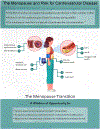Cardiovascular Disease in Women: Does Menopause Matter?
- PMID: 37274015
- PMCID: PMC10237361
- DOI: 10.1016/j.coemr.2022.100419
Cardiovascular Disease in Women: Does Menopause Matter?
Abstract
It is known that the menopause transition (MT) is a complex period during a woman's life, but there has been ongoing debate on whether the increase in cardiovascular disease (CVD) during midlife is due to chronological aging or ovarian aging. The purpose of this review is to summarize the recent findings on the role of ovarian aging versus chronological aging on cardiovascular disease (CVD) outcomes and its risk factors in women. Recent data from longitudinal studies have shown that menopause-related factors, such as earlier age at menopause and surgical menopause are associated with higher CVD outcomes. The MT is also associated with detrimental changes in vascular health as well as cardiometabolic risk factors including body composition, visceral fat accumulation, lipids/lipoproteins, blood pressure and the metabolic syndrome. The robust evidence from recent research indicating increases in CVD risk over the MT beyond aging call for immediate efforts to rise awareness among women and their health care providers of CVD risk acceleration accompanying the MT. Efforts should also be directed toward developing and testing novel preventive approaches that target women during this time period to counteract the expected increase in CVD risk.
Keywords: Menopause; cardiovascular disease; menopause transition; women’s health.
Conflict of interest statement
Declaration of Interest: None Declaration of Interest: Dr. El Khoudary: Supported by funds from NIA and NHLBI Dr. Nasr: Graduate Student Researcher on The Study Of women’s Health Across the Nation (SWAN) HDL
Figures


Similar articles
-
Menopause Transition and Cardiovascular Disease Risk: Implications for Timing of Early Prevention: A Scientific Statement From the American Heart Association.Circulation. 2020 Dec 22;142(25):e506-e532. doi: 10.1161/CIR.0000000000000912. Epub 2020 Nov 30. Circulation. 2020. PMID: 33251828 Review.
-
Menopause transition and cardiovascular disease risk.Maturitas. 2024 Jul;185:107974. doi: 10.1016/j.maturitas.2024.107974. Epub 2024 Mar 22. Maturitas. 2024. PMID: 38555760 Review.
-
Adverse Changes in Body Composition During the Menopausal Transition and Relation to Cardiovascular Risk: A Contemporary Review.Womens Health Rep (New Rochelle). 2022 Jun 13;3(1):573-581. doi: 10.1089/whr.2021.0119. eCollection 2022. Womens Health Rep (New Rochelle). 2022. PMID: 35814604 Free PMC article. Review.
-
Body composition and cardiometabolic health across the menopause transition.Obesity (Silver Spring). 2022 Jan;30(1):14-27. doi: 10.1002/oby.23289. Obesity (Silver Spring). 2022. PMID: 34932890 Free PMC article. Review.
-
A Woman's Heart: Improving Uptake and Awareness of Cardiovascular Screening for Middle-Aged Populations.Int J Womens Health. 2023 Jul 24;15:1171-1183. doi: 10.2147/IJWH.S328441. eCollection 2023. Int J Womens Health. 2023. PMID: 37520181 Free PMC article. Review.
Cited by
-
Unveiling the pathophysiology of restless legs syndrome through transcriptome analysis.iScience. 2024 Mar 26;27(4):109568. doi: 10.1016/j.isci.2024.109568. eCollection 2024 Apr 19. iScience. 2024. PMID: 38617564 Free PMC article.
-
Awareness and Knowledge of Cardiovascular Diseases and Its Risk Factors Among Women of Reproductive Age: A Scoping Review.Cureus. 2023 Dec 2;15(12):e49839. doi: 10.7759/cureus.49839. eCollection 2023 Dec. Cureus. 2023. PMID: 38164316 Free PMC article.
-
Cardiovascular Disease Risk in Women with Menopause.J Clin Med. 2025 May 23;14(11):3663. doi: 10.3390/jcm14113663. J Clin Med. 2025. PMID: 40507425 Free PMC article. Review.
-
Experiences of hot flashes, urinary incontinence and mood among South Asian American women: the MASALA study.Climacteric. 2025 Apr 3:1-8. doi: 10.1080/13697137.2025.2480584. Online ahead of print. Climacteric. 2025. PMID: 40177961
-
Sex in cardiovascular disease: Why this biological variable should be considered in in vitro models.Sci Adv. 2024 May 10;10(19):eadn3510. doi: 10.1126/sciadv.adn3510. Epub 2024 May 10. Sci Adv. 2024. PMID: 38728407 Free PMC article. Review.
References
-
- Virani SS, Alonso A, Benjamin EJ, Bittencourt MS, Callaway CW, Carson AP, Chamberlain AM, Chang AR, Cheng S, Delling FN, et al. Heart Disease and Stroke Statistics-2020 Update: A Report From the American Heart Association. Circulation. 2020;141(9):e139–e59610.1161/CIR.0000000000000757 - DOI - PubMed
-
- Dam V, van der Schouw YT, Onland-Moret NC, Groenwold RHH, Peters SAE, Burgess S, Wood AM, Chirlaque MD, Moons KGM, Oliver-Williams C, et al. Association of menopausal characteristics and risk of coronary heart disease: a pan-European case-cohort analysis. Int J Epidemiol. 2019;48(4):1275–128510.1093/ije/dyz016 - DOI - PMC - PubMed
Grants and funding
LinkOut - more resources
Full Text Sources
Miscellaneous
